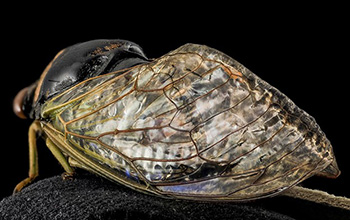
Research News
Investigation of insect surfaces led to new findings
July 23, 2020
Through the investigation of insect surfaces, Penn State researchers have detailed a previously unidentified nanostructure that can be used to engineer stronger, more resilient water repellent coatings.
Results of the U.S. National Science Foundation-funded research are published in Science Advances.
With an enhanced ability to repel droplets, this design could be applied to the surfaces of personal protective equipment and other items to better resist virus-laden particles, among other applications.
“For the past few decades, conventionally designed water repellent surfaces have usually been based on plants, like lotus leaves,” said Lin Wang of Penn State, the lead author of the paper.
However, this paper reveals an entirely different approach. When examining surfaces such as the eye of a mosquito, body of a springtail or wing of a cicada under high resolution electron microscopes, Wang found that the nanoscopic hairs on those surfaces are more densely packed.
With this knowledge gleaned from nature, the researchers hope to apply this design principle to create next generation coatings that can emulate insect surfaces, providing increased efficiency and safety. A water repellent surface that can withstand fast-moving, high-impact droplets has abundant applications, ranging from small, flying robotic vehicles to commercial airliners to personal protective equipment.
“We hope, when developed, this coating could be used for such things as PPE,” said Tak-Sing Wong, a mechanical and biomedical engineer at Penn State. “For example, if someone sneezes around a face shield, those are high velocity droplets. If the design principles detailed in this paper were adopted successfully, we would have the ability to repel those droplets much better and potentially keep a surface germ-free.”
Added Alexis Lewis, a program director in NSF’s Directorate for Engineering, “Innovations in materials engineering, processing and manufacturing like these have potential impact in applications addressing current societal and technological challenges. NSF’s Advanced Manufacturing program supports the fundamental scientific research that has led to such exciting breakthroughs.”
—
NSF Public Affairs,
researchnews@nsf.gov
Source: NSF News
Brought to you by China News







